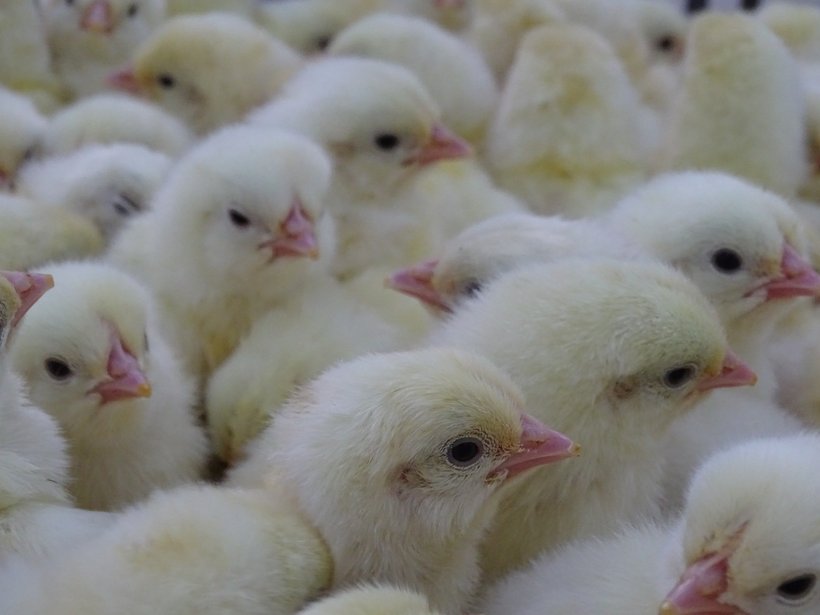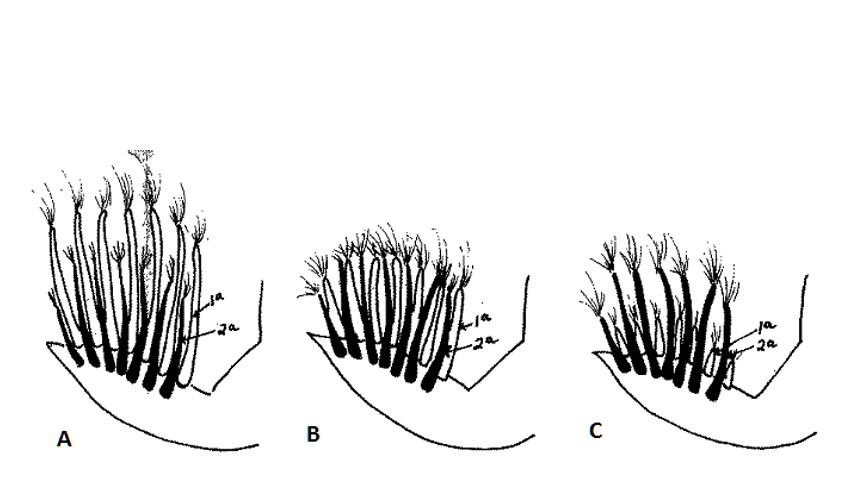
Published on Nov. 9, 2020
Feather sexing in Day-Old chicks
All the commercial white hybrid egg layers that are marketed under the Babcock, Bovans, Dekalb, Hisex, ISA and Shaver brands are sexable by their wing feathers at day-old. Feather sexing can also be applied in several brown or black laying hen breeds, this is depending on the hybrid supplied. In the commercial white egg layers show all the day-old commercial female chicks fast feathering and all day-old commercial male chicks show slow feathering. You might guess now, what does it mean, fast or slow feathering? In fast feathered day-old chicks, the primary wing feathers are thicker and longer than the covert feathers, in slow feathered day-old chicks, the primary and the covert feathers are similar in length and thickness.
Feather Sexing in Practice
Sexing of day-old chicks can be accomplished by different methods: 1) color sexing 2) vent sexing 3) feather sexing or 4) head spot sexing. Vent sexing can be done on all day-old chicks, whilst the other are limited to specific breeds and crosses. Each sexing method has its own challenges, or limitations, making training essential to increase the accuracy of sexing, and limiting the number of sexing errors. In this article we will explain the background and principles of feather sexing.
Feather sexing is based on differences in feather characteristics between day-old chick females and day-old males. It is relatively easy to train yourself to distinguish between males and females by feather sexing. Please note, the feather status is determined by genetics (it is in the genes), not all strains and breeds have been selected for feather sexing, therefor it cannot be applied in all products. In commercial brown egg laying strains, predominantly color sexing is applied. Most brown hybrids are fully homozygous (fast feathered) or heterozygous (both slow and fast feathered) in feathering, making feather sexing impossible. As color sexing can’t be applied in white egg layers (both females and males are born with yellow fluff), the breeding companies implemented feather sexing decades ago to allow for cost-effective sexing of day-old chicks.
The Benefits of Feather Sexing
The identification of sex in day-old chicks by checking the feather length has several clear advantages over vent sexing:
- Highly trained and specialized vent sexing personnel Special sorting personnel is not required. While vent sexing can only be carried out by highly trained personnel, feather-sexing can be carried out by personnel without training.
- The risk of infection via sexing operative is eliminated, especially risk of infection by Escherichia coli due to manipulation.
- There is a lower probability of mistakes: when one-day-old females are sexed for breeding purposes there is less risk of males slipping through.
- Feather sexing is faster than vent sexing, reducing time required to dispatch the chicks out of the hatcheries. One can hatch more chicks per hour because one is not hampered by the drawback of vent sexing operatives being capable of sexing only a restricted number of chicks per hour.
- Overall: the cost of sexing is much lower, and the speed much faster
Disadvantages of Feather Sexing
Feather-sexing can only be carried out in chicks resulting from the mating of fast normal-feathering males with delayed-feathering females, while vent sexing can be applied to any chicks. This means that feather-sexing cannot be applied to chicks of the same breed, unless geneticists preserve that breed segregating for both types of feathering and birds are strictly controlled for feathering type.
The preparation of new breeds to produce feather sexable crosses implies considerable previous genetic work which is completely beyond the means of most poultry farmers.
Genetics the K gene
The fast or slow feathering genotype is determined by the K gene (the feather development gene). The K gene is located on the Z chromosome (female chickens are ZW, male chickens are ZZ) and can be utilized to produce the fast and slow feathered phenotypes that distinguish between the male and female day-old chicks. Through controlled mating and selection, the K gene has been put into the white egg layers (the leghorns). In those genetic lines where sex-linked delayed feathering (i.e. slow feathering) did not originally occur, a special breeding program was applied to introduce the K gene. Feather sexing in commercials can be established when slow feathered female parent breeders are to be mated with fast feathered male parent breeders. The female progeny (the commercial laying hens) will all be fast feathered, the male offspring (the cockerels) will be slow feathered.
The Principle
When fast-feathered k+k+ roosters are mated to slow-feathered K hens, the sex of their progeny can be easily recognized at the day of hatch: resulting in fast feathered female chicks k+ and slow feathered male chicks Kk+. This difference in feathering happens because female birds carry a single Z chromosome (sex chromosome), the male birds carry two Z chromosomes.
There are 4 known alleles at the K locus, in the following order of dominance: Kn > Ks > K > k+.
| Genotype | Phenotype |
|---|---|
| k+ or k+k+ | Fast feathering |
| K or KK | Slow feathering |
| Kk+ | Slow feathering males (K s is dominant over k+) |
.
k+ (fast-feathering)
k+ is the most recessive of the allelic series. Day-old chicks pure for this allele have the primary remiges evidently longer than the coverlets (see Figure 1A). The fast-feathered chicks complete their feather growth much faster compared to the slow feathered chicks. Differences between fast and slow feathered chicks in the development of their feather cover can be seen during the entire rearing period.
K/Ks (delayed/slow feathering)
K is another dominant allele of the allelic series which controls feather growth rate. One-day-old chicks have primary remiges and coverlets of the same length (see Figure1B). Feather growth rate is slower (delayed) in slow feathered birds than in fast feathered birds, this delay is most visible during the first weeks of juvenile life, but can last till the end of rearing Fortunately, this allele has not any effect on adult plumage. Sex-linked delayed feathering is typical in the female lines of the white egg producing leghorns and many broiler breeds.
Kn (ultra-slow/ very slow/ delayed or super slow-feathering gene)
Kn ("naked") is the most dominant allele which affects feather growth rate. It is a gene whose impact on feather growth is quite extreme. Birds carrying this gene are almost completely naked during their juvenile life, cases are known that females remain nearly naked during their adult life as well. The day-old chicks lack their primary and secondary remiges completely, they may appear as extremely small pinfeathers. Birds carrying the Kn might also show reduced comb size and retarded growth. This ultra-slow feathering gene is believed to be associated with a bald patch on the back of the adolescent bird.

Figure 1. Feathering types Diagram of the wing of a one-day-old chick in dorsal view: A fast normal-feathering with the primary remiges (1a) longer than the coverlets (2a). B sex-linked delayed feathering with the primary remiges (1a) of the same length than the coverlets (2a). C modified delayed feathering with the primary remiges. (1a) shorter than the coverlets (2a).
source: Wikiwand
Take Home Message
As the feathering status of the parent stock flock is crucial for feather sexing in commercial day-old chicks it is advised to check for any sexing error that might have slipped through the hatcheries. Whether it is a sexing error male, or a sexing error female, make sure you always remove them out of the parent stock population . One single sexing error in the parent stock can generate plenty of offspring in which feather sexing can no longer be successfully applied. Especially parent stock males can have a big impact as they mate with so many females. In the white parent stock flocks, the sexing errors can easily be identified by the status of their comb: all leghorns males with non-dubbed combs should be taken out, this also accounts for the parent stock females with dubbed combs.
